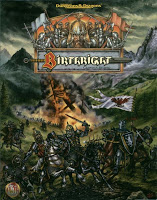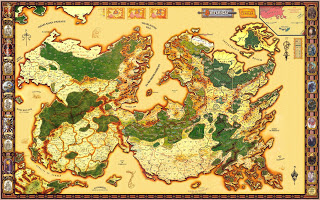I wasn’t a fan of the Birthright campaign setting when it first came out in 1995. To me, it seemed like just another in a multitude of settings that TSR was cranking out, and although I had a vague notion that it had something to do with starting off as the leader of a realm (or something equivalent), I never really pursued it. It seems I wasn’t alone, since the setting was retired without fanfare in 1999. In retrospect, this shouldn’t be all that surprising, because while there was a plethora (some might say “glut”) of setting accessories, there were only five actual adventures published for it. Especially for a setting with a different emphasis such as this one, published adventures should have been used to demonstrate the possibilities.
Although I still wouldn’t call myself a fan of the setting (in the same way that I consider myself a fan of Greyhawk, the Forgotten Realms, Wilderlands, and Dragonlance), my stance on Birthright has certainly softened over the years to a place where I can appreciate many of its finer points, and (naturally) seeing how they might be brought into the World of Greyhawk.
If you’re not familiar with the setting itself this excellent review by Ross Watson over at Rogue Warden can give you the outline. I’ve got to say, I’m still not too much of a fan of the actual setting itself. The old gods are dead (but there’s no really compelling reason for that, since new gods have taken their places), there are seemingly arbitrary changes to humanoids and demi-humans, and although I get they were going for an epic sweep of history, it just never hit me that way. It just seemed a rather mundane collection of medieval kingdoms with some Really Weird Things thrown in to prove that it’s a fantasy setting. I’m also not a fan of the “bloodline” idea (nor did I like the film “Highlander”, btw); I’d much rather see a non-magical “regency” mechanic, that anyone could avail themselves of, take its place.
Lest this seem like a hate-fest on Birthright, what I do like about the setting are the domain rules and associated mechanics. In fact, this is what drew me to take another look at the setting, as I was doing research for my upcoming Adventures Great and Glorious project. There is a comprehensive system for four types of “holdings”– law, guild, temple, and Source (Source holdings are a measure of the magical power inherent in the land). Based on the population of the provinces under a given regent’s control, they are then able to do various domain actions; moving armies, constructing settlements and fortifications, etc.
I think there’s a lot of potential there for application in other settings. Since the Birthright province is approximately 30-40 miles across, they would seem to map well to the 30 mile hexes on the map of the Flanaess from the World of Greyhawk. If one took out the notion of the regents needing some sort of mystical blood line to access the power of their domains, and replaced it with… something else… I can really see it working for larger-scale Greyhawk games.
Plus the whole notion of “realm spells” is one that’s both obvious and overdue. Simply put, they’re like ordinary spells, but have a much more far-reaching effect and naturally take much longer to cast. Spells like legion of dead or blight are just too good not to have in a game on that scale, but once again some mechanism would have to be brought in to replace the restriction that only regents with their magical bloodlines can tap into the Source of provinces to cast such spells. I would hesitate to simply remove it, because that would certainly throw an “ordinary” game out of balance should an adventurer somehow gain access to the spell. (“I’m going to take my regiment of zombies into the dungeon…”)
Birthright has a system for mass combat, and it looks like it would work fine, but it’s a bit abstract for my own personal tastes. For someone who didn’t share my predilection for miniatures wargaming, though, I’m sure it would do fine.
So there it is. While I’m still a little “meh” when it comes to the setting of Cerilia itself, there’s a lot of good stuff in Birthright that would work in other settings with some tinkering.











That's a very nice map.
Isn't it? Damn, I would kill to have a map like that of the Flanaess.
As someone who did try to run BR for the GH setting, I can say it's alot of bookkeeping but yes functionally more realistic than the no-frills domain system of BECMI which I still adore. I mainly utilized it for the GK which according to the BR system was ridiculously wealthy and powerful due to landmass and population. Taken out of domain context and put into the hands of PCs, why would they bother adventuring with so much manpower and gold at their disposal? Just a thought.
I also did like their mass combat. a series of unit cards that you array on a poster sized battlefield with zones to maneuver your forces and so on(would be perfect in today's MtG crowd). Again, it was quite colorful and innovative back then when I mainly used the hard-stat based Warmachine rules from the Companion set. As an older gamer today, yes I would prefer minis but that's more to do with the fact I can afford to now.
Good topic joe, and I hope you do get that old style GH map…;)
I've always had a love/hate relationship with Birthright. The ideas in it are fascinating, but the execution just lacks, and it smacks of "special snowflake syndrome" that would eventually dominate the entire game. But it still has a lot of cool left in it.
As for the "magical regency" aspect, I undertand not liking that. But I'd had a thought a while ago about replacing it with the concept of a Fisher King type angle. Some folks are just bonded to the land. You can rule a province, but in order to really and truly be it's leader, it's lord, you have to be bound to it in the same way that Arthur was England/Albion. You assume the rights and responsibilities of governing that particular patch of the world and gain everything that goes with it. Perhaps there's a ritual, ceremony, or some sort of investiture involved, such as a coronation ceremony in our own world, but the effect remains the same.
it's not magic, per se, but it sort of tones down that aspect of things so that you don't have the bloodline of a dead deity in you.
I don't suppose you still have the notes stashed away from that campaign, Mort? I'd love to see that.
Yes the setting itself is fairly bland, or rather, yet another generic fantasy setting. But I believe that was the actual goal – to provide a setting that everyone already knew. The real highlight of Birthright was the domain system and that is what made it special. Similar to toast and jam, the setting is the toast and domain rules were the jam.
I ran two different Birthright campaigns and both were a lot of fun. A friend of mine right now is running two 4E Birthright games and I am on the waiting list to join one of them.
And every once in while my eyes wander to the shelf holding all my Birthright books, wondering if I should run a 2E game again.
I might have some notes squirreled away, but I can't be certain of the accuracy of the math using those rules.
I disagree with a lot of the complaints. In my opinion, Birthright is an incredible acievement. I think the initial set has perhaps the highest production quality of any TSR release, ever. It is also filled with unique ideas, both in flavor and mechanics. It is one of few RPG products that has ever really astonished me with its creativity and production quality.
Roger Moore tried mapping Birthright onto Greyhawk at one point, and found, (in my recollection) that the Birthright "continent" was only slightly larger than Nyrond.
I like that BR took chances with some of the D&D tropes. It was actually closer to my perception, and I get very tired of the same old same old in every setting.